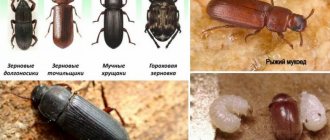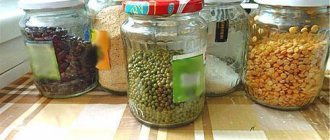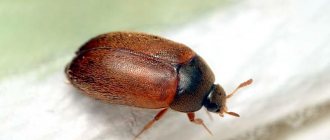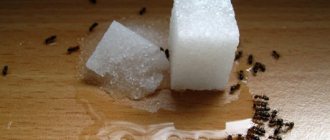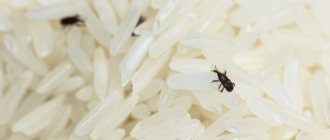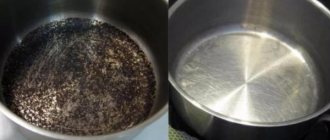One of the most useful and easy-to-maintain garden crops is beans. But gardeners often notice that bugs gradually appear in the harvested crop. This happens not only due to improper storage of the crop; the appearance of bugs in beans may also be due to its irrational harvesting. The main pests of legumes include aphids, weevils, sprout flies, root nodule weevils, whiteflies, and codling moths. To eliminate the possibility of their occurrence, every summer resident needs to know the measures to prevent and combat them.
Where do insects come to us from?
Many housewives who carefully keep their house clean often wonder: why are there bugs in the beans? Most often, insects appear due to the fact that sanitary standards are poorly observed in factories. Such consequences can be caused by neglect of heat treatment and violation of storage rules. This is why beans sold in stores may initially contain pests.
Beetles can also appear in beans by moving into them from neighboring products. Most often, bugs move into beans made from flour and starch.
What harm do they cause?
The bugs that appeared in the beans begin to actively eat the beans, filling the vacated space with the products of their own vital activity. Due to damage to the bean structure, it becomes unsuitable for further sowing. Moreover, such beans lose their beneficial and nutritional properties, so they are strictly forbidden to be eaten.
How to fight?
Methods of bean pest control include proper preparation of the harvested crop for storage and ensuring the correct conditions for the preservation of beans. To do this, you need to know the optimal temperature, humidity level, and method of calcining the beans.
What to do if bugs are already infested in the crop? Unfortunately, such a product becomes unsuitable for consumption and further planting, so it must be thrown away.
To prevent crop contamination, you need to know the rules for controlling major pests. You can cope with bean weevil by treating the plants with Metafox and Decis before flowering. Repeated treatment is done 10 days after the first.
See also
Description of the best varieties and types of green beans with namesRead
If previous plants were affected by the sprout fly, next time it is necessary to perform the following preparatory steps:
- remove all weeds from the site;
- organize sowing in the early period: at a soil temperature of 10 degrees;
- if manure is used, it must be buried in the soil;
- Before sowing, grains must be soaked in a growth stimulator.
To protect plants from slugs, the soil around the planting should be covered with dry nettle stems. They will scare away pests and the harvest will be preserved.
To combat aphids, you need to spray the plants with a soap solution. You should also water the plantings with fertilizer made from nettles.
Ways to fight
You can protect yourself from bugs in beans if you carefully monitor the harvest. To do this, it is recommended to frequently sort through the legumes in order to notice the appearance of bugs in time. Just emerging insects will not have time to spoil a large number of beans. Then the affected grains are thrown away along with the insects. The rest are treated with cold or high temperature.
To do this, the beans are placed in the freezer or oven for a short time. If there are clutches of eggs left in the grains, they die under the influence of low or high temperatures.
You can cope with bean pests with the help of small tricks. Some insects are frightened by strong aromas. Therefore, several cloves of garlic are placed in the container where the beans are stored. Place cloves, nutmeg or bay leaves in the pantry or kitchen where beans are stored.
Important!
An effective preventive measure against bugs is periodic sanitization of storage containers.
Where and in what should beans be stored?
Due to the fact that beans need to be kept cold, the refrigerator is considered the only optimal place until such time. If the beans are dried, they can be poured into a bag made of natural linen, and then placed in the vegetable compartment or on the door.
To protect yourself as much as possible from the appearance of pests, you need to place unpeeled garlic cloves and dill seeds next to the beans. Such additions repel pests. In winter, the beans can be transferred to the balcony.
How to prepare for storage?
Since the bean beetle penetrates the beans at the stage of their ripening, before storing the harvested crop, it must be prepared. Before laying, the beans should be sorted and dried. To do this, they need to be placed in an oven preheated to 80-90 degrees for 5 minutes. After such heat treatment, the grains lose their ability to germinate, so such beans must be eaten. Many gardeners claim that in order to ensure a longer shelf life of beans, they should be separated from the pods.
Habitats
The homeland of these insects is America. It was from there that the bean weevil began its journey around the world on merchant ships. At the end of the 19th century, it was brought to Europe, from where the insect came to Russia during the civil war at the beginning of the last century.
The absence of natural enemies and food competitors allowed the insect to rapidly conquer large territories. The error is now common on all continents except Antarctica.
In the territory of the former Soviet Union, the bean weevil constantly lives in the Krasnodar Territory, Crimea, Tula, Ryazan regions, Georgia, Ukraine, Moldova and Azerbaijan. The northernmost regions are characterized by focal distribution.
The parasite, brought with the crop for storage, leaves from there into the natural environment only in the summer.
Pests
Most often, beans are affected by bean weevil, sprout fly, slugs, and aphids. Therefore, the summer resident needs to know the characteristics and reasons for the appearance of these pests in the crop.
Bean grain
This pest affects bean crops in all regions, but most often it appears in the southern territories, which have a warm climate. The pest is a small beetle whose size ranges from 2-5 millimeters. Their body is characterized by an oval shape and a black shell. There are gray-yellowish stripes on the back. The bean weevil can fly long distances and also survive without food for 3 months.
The bean weevil is a heat-loving insect that does not tolerate cold weather. If the ambient temperature drops below zero, the pest dies.
See also
How to properly grow beans at home, step by step for beginnersRead
Sprout fly
This pest is distinguished by its gray color, with darkening stripes on its back. Its length can reach 5 millimeters.
The insect lays eggs in the soil in April or May. If the weather is humid, larvae hatch from the eggs after 9 days. If weather conditions are dry, the eggs die. The surviving larvae penetrate the grains through the thinnest membrane in the area of sprout formation.
Slugs
The appearance of these pests is detected when traces of mucus are detected. During the day, slugs hide in the shade, and at night they go in search of food. They die if the temperature drops below 7 degrees.
Aphid
This pest is small in size, not exceeding 5 millimeters. It settles on new shoots and lower leaf blades. Such insects feed on plant sap, so such exposure can not only lead to the death of the crop, but also the entire plant.
Peculiarities of bean seed propagation
Under natural conditions, bean grain propagation occurs during fruit ripening. The female gnaws a hole in the seam of the bean and lays 15-20 white oblong eggs in it. The length of the embryo does not exceed 0.2 mm. The fertility of one female varies from 60 to 200 eggs. The weevil beetle is quite fastidious and its reproduction is possible under appropriate conditions:
- optimal humidity 60-70%;
- ambient temperature is 15-30 °C, at higher temperatures the eggs die;
- availability of nutritional base. Bean grain
In the warm season, embryo development lasts 7-14 days, at lower temperatures 35-40 days. The hatched bean kernel larvae penetrate deep into the bean and then into the grain itself. Newborns have 3 pairs of legs, are distinguished by mobility and the presence of bristles. Several dozen larvae can simultaneously coexist in one bean seed; they eat the contents of the bean and gnaw tunnels in it. The larval maturation stage lasts 3 weeks and ends with pupation.
The young beetle easily gnaws a hole in the bean and leaves it. The full development cycle of the weevil ends in September and October, and most often the larvae enter the storage with the harvest.
Important!
In field conditions, the female gives 2 generations, in the southern regions 3-4. In heated rooms, under favorable conditions, insects breed year-round.
Diseases
In addition to pests, beans can also be destroyed by diseases. There are several reasons why beans turn black. To understand this, you need to know the main features of the diseases of this culture.
Powdery mildew
This disease is characterized by the appearance of a whitish coating on the leaves and stems of the plant. Gradually, the affected areas turn yellow.
Anthracnose
This pathology is distinguished by the fact that brown spots form on leaves, fruits, and stems. The leaves dry out and burgundy sores form on the fruits.
White rot
Affects stems and fruits. The infected areas become soft and gradually turn white. Rotting leads to the death of the planting.
Root rot
A whitish-pinkish coating appears on the roots. The beans are stunted and gradually die.
Bacterial spot
Under the influence of this pathology, the plant turns black. First, spots appear on it, which merge together over time. Gradually the planting fades.
Bean mosaic
With this disease, the leaves become variegated in color. Gradually, the leaves wrinkle and the plant withers.
Protection measures
To protect plants from these diseases, it is necessary to get rid of pests, which often become their carriers. You should also provide optimal growth conditions for plantings and maintain humidity at the required level.
Preventive
If a summer resident is afraid that the beans will be affected by pests, he should prevent their occurrence. Most often, it is enough to use folk remedies that recommend covering the soil around the plants with dried nettles. You can also water the plantings with garlic broth, which will also repel pests.
Active
During the growth of the crop, the gardener is obliged to monitor the timeliness of development and the condition of the legume plant . This is necessary to identify the presence of a pest or disease at an early stage. Timely treatment will save not only the plant, but also the harvest.
Preparing in pods will freezing help?
Freezing is an excellent method of storing pods, which will protect the crop from pests.
During the harvesting process, it is important to follow simple rules:
- The pods are washed and dried well.
- Each pod is cut into pieces no longer than 3 cm.
- The product is blanched in boiling salted water for 5 minutes.
- The pods are taken out of the pan and placed on a paper napkin or clean cloth. After complete drying, the supplies are placed in plastic containers.
- When laying, you need to focus on the amount of product used at a time.
- Re-freezing of the product is not allowed.
https://youtube.com/watch?v=cD4AEbdGjuI%3Ffeature%3Doembed
